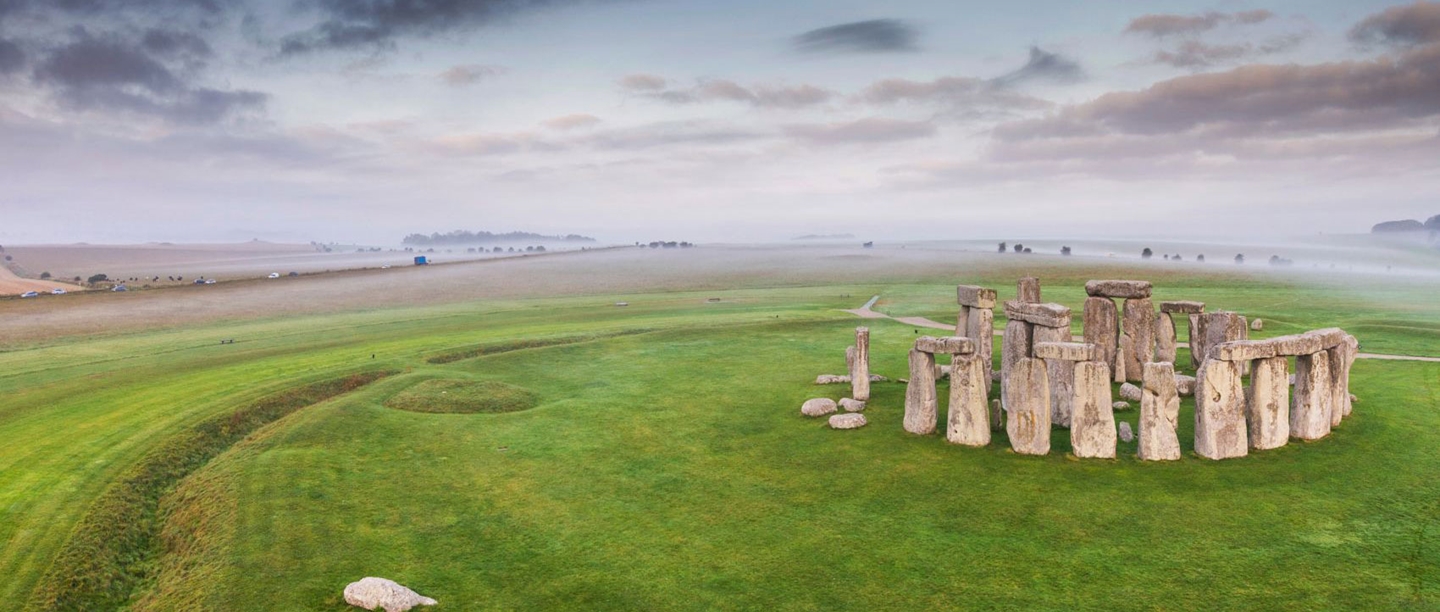The Heel Stone
This huge unshaped boulder of hard sarsen stone stands in isolation surrounded by a small circular ditch. It weighs more than 36 tonnes! In 1979, the hole for another similar-sized stone was discovered next to it, which may have been the original position of the Heel Stone. Or, there may once have been a pair of upright sarsens immediately outside the entrance to the earthwork enclosure.
Lintels
There are only six remaining lintels of the outer sarsen circle in place at Stonehenge, but if it was ever completed, there would have been an unbroken ring of stone, 30m in diameter, suspended 4m above the ground. Each lintel is locked to its supporting upright sarsens with a mortice and tenon joint, and to its neighbours by tongue and groove joints – techniques more commonly found in woodworking. Further evidence of the care that went into the construction is that the inner and outer faces of the lintels are gently worked to better give the illusion of a continuous ring of stone. Additionally, the tops of the upright stones have been levelled to overcome the effect of the slope on which they are set, resulting in no more than a few centimetres difference in height across the diameter of the circle.
Image: (c) Alex Mills
The Station Stones
Originally four, there are now two remaining Station Stones which were probably put in place at the same time that the central sarsen stones were raised. In this photograph, the small stone in the background is one of them. They mark the corners of a perfect rectangle with its central point in the exact centre of the monument. The reason for this alignment is uncertain, but they mirror the solstice alignment of the stones, and may also mark a lunar alignment.
Stone 52
Graffiti old and new is present on many of the stones at Stonehenge. Stone 52 bears the name Wren and is thought to have been carved by St Pauls Cathedral architect Sir Christopher Wren, whose family had a home nearby.
The Slaughter Stone
This large sarsen gets its gruesome name from the over-active imagination of the Victorians. Originally standing upright at the entrance to Stonehenge and flanked by additional stones that are now missing, the surviving stone lies horizontally. Shallow depressions on its surface collect rainwater which reacts with iron in the stone and turns a rusty red. This red water may have been inspiration for the stone’s lurid but inaccurate name!
The Sarsens
The outermost setting of Stonehenge, if completed, was a circle of 30 upright sarsens, capped by horizontal lintel stones all carefully shaped. The source of most of the sarsens is generally accepted as being on the Marlborough Downs, some 19 miles to the north, although new research on their origin is currently underway. When freshly worked, the surface of the sarsens would have appeared much brighter and whiter than the grey stones you see at Stonehenge today.
Stone 56
The tallest of the sarsens at Stonehenge, Stone 56 is the only remaining upright of the tallest trilithon at the head of the inner horseshoe. This stone was carefully worked to create a vertical side, which would have been the slot through which the setting sun at winter solstice could have been viewed, before the other half of the trilithon fell. Stone 56 has an obvious tenon on top, and there are corresponding mortice holes visible on the now fallen lintel.
Stone 68
There were up to 80 bluestones brought from the Preseli Hills in south-west Wales to Stonehenge. Some show no signs of working but some, like Stone 68, are elegantly grooved, and this was probably intended to be jointed to another stone that has a corresponding tongue. This shaping suggests that the stone was relocated here after having been used previously in some other arrangement, perhaps as part of the double bluestone arc.
Stone 53
In 1953, Professor Atkinson was the first to notice the outline of a dagger and axe blades carved into the surface of one of the trilithon uprights. The shape of the weapons and tools suggest that they date to the earlier part of the Bronze Age, between 1750 and 1500BC, so were later additions to the monument.
Altar Stone
Partially buried beneath two of the fallen stones of the largest trilithon lies the Altar Stone. This is the largest of the non-sarsen stones, a large slab of greenish Old Red Sandstone. Recent geological research has pinpointed the source of this stone as probably the Brecon Beacons area of south-east Wales. It is not known whether the Altar Stone originally lay flat as an altar-like slab or if it stood upright.
Stone 60
The sole surviving upright of another trilithon, Stone 60 had a huge hole at its base, large enough for several people to shelter under during bad weather. In 1959 during a programme of restoration, the stone was straightened and the hole filled with concrete.

